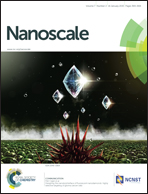Polymer nanocomposite films with extremely high nanoparticle loadings via capillary rise infiltration (CaRI)†
Abstract
Polymer nanocomposite films (PNCFs) with extremely high concentrations of nanoparticles are important components in energy storage and conversion devices and also find use as protective coatings in various applications. PNCFs with high loadings of nanoparticles, however, are difficult to prepare because of the poor processability of polymer-nanoparticle mixtures with high concentrations of nanoparticles even at an elevated temperature. This problem is exacerbated when anisotropic nanoparticles are the desired filler materials. Here we report a straightforward method for generating PNCFs with extremely high loadings of nanoparticles. Our method is based on what we call capillary rise infiltration (CaRI) of polymer into a dense packing of nanoparticles. CaRI consists of two simple steps: (1) the preparation of a two-layer film, consisting of a porous layer of nanoparticles and a layer of polymer and (2) annealing of the bilayer structure above the temperature that imparts mobility to the polymer (e.g., glass transition of the polymer). The second step leads to polymer infiltration into the interstices of the nanoparticle layer, reminiscent of the capillary rise of simple fluid into a narrow capillary or a packing of granules. We use in situ spectroscopic ellipsometry and a three-layer Cauchy model to follow the capillary rise of polystyrene into the random network of nanoparticles. The infiltration of polystyrene into a densely packed TiO2 nanoparticle layer is shown to follow the classical Lucas–Washburn type of behaviour. We also demonstrate that PNCFs with densely packed anisotropic TiO2 nanoparticles can be readily generated by spin coating anisotropic TiO2 nanoparticles atop a polystyrene film and subsequently thermally annealing the bilayer film. We show that CaRI leads to PNCFs with modulus, hardness and scratch resistance that are far superior to the properties of films of the component materials. In addition, CaRI fills in cracks that may exist in the nanoparticle layer, leading to the healing of nanoparticle films and the formation of defect-free PNCFs. We believe this approach is widely applicable for the preparation of PNCFs with extremely high loading of nanoparticles and potentially provides a unique approach to study capillarity-induced transport of polymers under extreme confinement.


 Please wait while we load your content...
Please wait while we load your content...